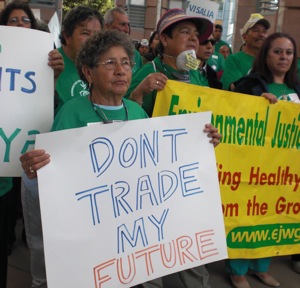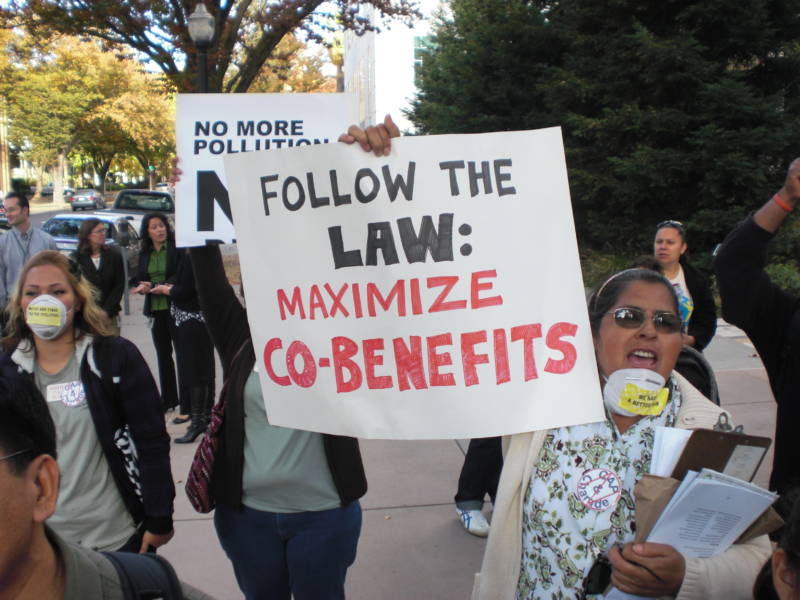Environmental Justice groups say they support California’s climate law. So why did they sue?
Environmentalists may seem the most unlikely of sources stalling the state’s landmark climate change law. But the case brought by a group of environmental justice advocates is bringing up issues that have been largely overlooked in the zeal of carrying forward AB 32.

This means that a California power plant can increase CO2 emissions if it buys allowances from another industry that’s reducing emissions, or offsets from, say, a tree farm in Canada.
“The evidence out there is that cap-and-trade is going to fail these communities and will continue to allow polluters to dump on them, and that’s unacceptable and it’s also illegal,” said Alegria De La Cruz, legal director at the Center on Race, Poverty & the Environment in San Francisco. The Center is a plaintiff in a lawsuit filed by several organizations over the implementation plan for AB 32. Parties in that case are awaiting finalization of a state court ruling that could hold up the scheduled launch of California’s cap & trade plan.
De La Cruz says the industrial sector, including oil refineries and power plants, are a problem for nearby communities like Richmond in the Bay Area and Wilmington, near Los Angeles.
Citing the pending litigation, the California Air Resources Board declined to comment on environmental justice concerns, and instead referred me to UCLA law professor Ann Carlson, faculty director of the Emmett Center on Climate Change and the Environment.
Carlson agrees that there’s nothing in the regulations that ensures communities living close to refineries, power plants, and other polluting sources see a direct benefit from cap-and-trade. But, she says, industries will still be subject to other environmental laws like the Clean Air Act, which prevent them from exceeding certain limits on conventional pollutants that are harmful to public health.
“AB 32 in no way relaxes existing environmental laws so I don’t see how there is more [conventional] pollution because they continue to be regulated in the same fashion as previously,” Carlson says.
De La Cruz brought up another problem she sees with cap-and-trade: its exemption of the agricultural sector, which emits large amounts of methane, a potent greenhouse gas and air pollutant.

“Agricultural communities are even more problematic because they’re actually going to be allowed to be offsets,” she says. “So you’re taking an industry that’s a polluting industry and calling it something that really mis-characterizes what it does to the environment. It really doesn’t make sense.”
Carlson says she believes CARB exempted the agricultural sector because it’s hard to measure and control farmland emissions, since there is no single source. She says that she believes CARB is being very careful of what qualifies for offsets, a mechanism which allows industry to “offset” some of their own emissions by funding qualified projects to reduce emissions elsewhere.
The environmental justice groups are using litigation to try and force the California Air Resources Board to reconsider the cap-and-trade portion of the law. De La Cruz says there are other options to cap-and-trade. The state could directly regulate polluters by placing a fee on carbon. The money generated could, in part, go toward a rebate for low-income people to buy higher-priced energy.
The state has nine years to meet the AB 32 greenhouse gas reduction targets. Enough time, says De La Cruz says, to retool cap-and-trade without causing delays. She said environmental justice groups do want to see AB 32 succeed–but not at the expense of poor communities.
Alison Hawkes is a San Francisco-based freelance reporter and co-founder of Way Out West News.
One thought on “Why EJ Groups are Leery of Cap & Trade”
Comments are closed.

Professor Carlson is just plain wrong about the Clean Air Act preventing any harm from Cap and Trade to communities living near major industrial emitters. First of all, those communities will not see the benefits of co-pollutant reductions at the industrial source if that source buys allowance or offsets from another source (which could be out of state). Offsets and allowances are reductions of pollution that one source sells to another, which allows the purchasing source to do nothing. Co-pollutants include smog forming gas, particulate matter, and toxic air pollution that industrial sources typically emit. An industrial source will buy pollution reductions from someone else when the market price for CO2 is cheaper than on-site reductions. That will deprive nearby communities from the benefit of reduced pollution. The Clean Air Act does nothing to make up for that lost benefit.
Second, if an industrial source expands (like a refinery expansion), then there will be an increase in both CO2 and co-pollutants. In that situation, the Clean Air Act says that the source must use technology to control pollution, but only if it is cost-effective. For that pollution which is not controlled by technology, the source must buy offsets from another source. Sound familiar? This pollution trading program is called “New Source Review” and it applies in Los Angeles, the Central Valley, and the Bay Area. Just like Cap and Trade, under New Source Review, the community gets to breathe the pollution when the industrial source buys “pollution credits” from somone else. Again, the Clean Air Act is not helping those communities living near industrial sources.
Professor Carlson is also wrong about agricultural sources. One of the biggest sources of green house gases are dairies, which emit massive amounts of methane from decomposing waste in “lagoons” and from the cows themselves. Methane is 23 times as powerful as CO2. ARB and UC Davis have done a great deal of research on the amount of methane, so knowing how much and from where dairies emit methane is not the problem. The problem is that the dairy industry does not want to pay to install methane digesters, and instead wants to make money by selling offsets to refineries and other industrial sources (see above). ARB was happy to oblige.